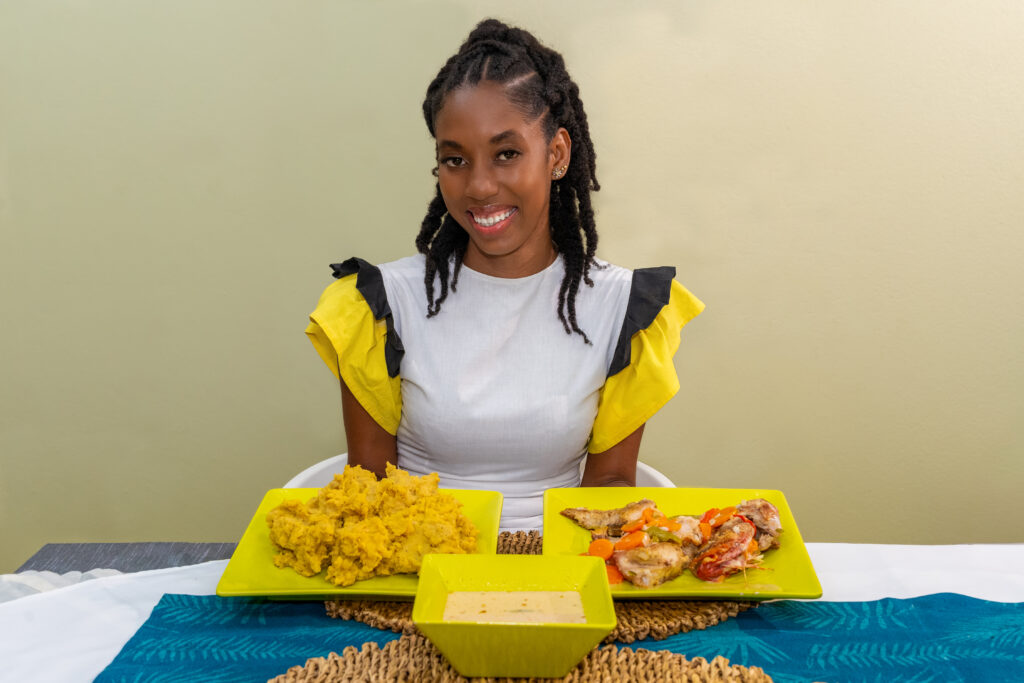FOOD & CULINARY TRADITION

Text by Karen Martinez, Felicia Nunez, and Roy Cayetano)
Excerpt from the book “Gifts from My Heart and My Fireheart” by Felicia Nunez)
Traditional Garifuna cuisine reflects the rich cultural heritage of the Garifuna people, with staple foods including cassava, plantains, bananas, and various ground provisions. These are typically prepared using coconut milk or locally made coconut oil, adding a distinctive flavour to the dishes. Fish is the primary source of protein, complemented by game meat or domesticated birds such as chicken or duck. A variety of herbs and spices are often used, giving Garifuna food its unique and cherished taste.
Cassava: The Cornerstone of Garifuna Cuisine
Cassava is one of the most versatile ingredients in Garifuna cooking. This root vegetable thrives in tropical climates, even on marginal and low-fertility land. Before use, the tuber is peeled, washed, and either cooked whole or incorporated into stews and soups.
Cassava can also be grated, dried, and transformed into flour. Products derived from grated cassava include:
– Cassava meal (farina)
– Cassava flatbread (ereba)
– King cassava (morumoutimarumaruti)
– Cassava pudding and porridge (sahousaháü)
– Cassava starch**, traditionally used as baby food
In some regions, the liquid extracted during cassava processing is used to make cassareep (*dumari* or *giunti*), though this is no longer common practice among the Garinagu in Belize.
The tools used in cassava preparation, such as the *ruguma*, *hibise*, *budari*, and *béisawa*, are inherited from Carib and Arawak ancestors, highlighting the deep cultural roots of this culinary tradition. Cooking is often done over an open flame or *fire hearth*, imparting a distinctive smoky flavour that is beloved by many.
Bananas and Plantains: Versatile Staples
Bananas and plantains are integral to Garifuna cuisine, often prepared with coconut milk. Bananas can be peeled, sliced, or diced to create dishes like *tapou tapóu* or *chaüngua-chonguachaüngua*. Grated bananas are also used to make *búndiga* and *darasa*.
Plantains are boiled and then pounded to make *hudutu*, a dish featuring a coconut stew with fish. The coconut milk is carefully stirred to prevent curdling, and the stew is seasoned with local herbs and okra.
Another traditional dish is the *boil-up*, which combines starchy foods cooked in coconut milk, flavoured with herbs, garlic, and onion for a hearty and satisfying meal.
Evolving Culinary Practices
While these heritage foods remain central to Garifuna culture, modern adaptations have emerged to suit changing lifestyles and tastes. It is increasingly common to see variations in traditional recipes, incorporating new ingredients or substituting protein sources and coconut milk to meet contemporary dietary needs.
—
Hudutu Baruru Falumoun Recipe

Ingredients:
– 6–7 green plantains
– 2 grated coconuts
– 2 lbs fish
– 1 onion
– 4 cilantro leaves
Preparation:
1. Grate the coconuts. Add water and squeeze out the milk into a cooking pot.
2. Add spices and fish to the pot, cooking the fish until done. Stir constantly to prevent the coconut milk from curdling.
3. Peel and wash the green plantains. Cook them in water without salt until softened.
4. Once cooled, place the plantains in a mortar and pound them with a pestle. Dip the pestle in cold water regularly to prevent sticking. Continue pounding until the plantains are soft, sticky, and hold together.
5. Remove the mashed plantains from the mortar and serve with the fish and coconut milk gravy.
This traditional dish embodies the essence of Garifuna culinary heritage, combining simple, natural ingredients with timeless techniques to create a meal that nourishes both body and soul.
